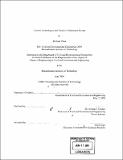| dc.contributor.advisor | Jerome J Connor. | en_US |
| dc.contributor.author | Chen, Michael, 1981- | en_US |
| dc.contributor.other | Massachusetts Institute of Technology. Dept. of Civil and Environmental Engineering. | en_US |
| dc.date.accessioned | 2006-02-02T18:49:17Z | |
| dc.date.available | 2006-02-02T18:49:17Z | |
| dc.date.copyright | 2004 | en_US |
| dc.date.issued | 2004 | en_US |
| dc.identifier.uri | http://hdl.handle.net/1721.1/31111 | |
| dc.description | Thesis (M. Eng.)--Massachusetts Institute of Technology, Dept. of Civil and Environmental Engineering, 2004. | en_US |
| dc.description | Includes bibliographical references (p. 50). | en_US |
| dc.description.abstract | A literature review of current aluminum technology in the building and construction industry was carried out. Aluminum is an ideal material for building in corrosive environments and for building structures where small dead loads are desired. This has led to the increased use of aluminum in industrial areas and bridge retrofitting projects. By replacing conventional concrete decks of a bridge with aluminum decks, not only is the dead load red load capacity of the bridge is increased. However, there are design issues related with aluminum construction that must be carefully considered. Issues such as welding and temperature effects play a major factor in the application of aluminum in design and construction. Depending on the alloy and temper, welding of aluminum can reduce the strength of an aluminum alloy by half in heat-affected zones. A life cycle assessment of aluminum production is discussed. Green-house gas emissions from aluminum production over the past several decades have declined consistently due to new smelting technologies. In addition, a great amount of aluminum in use today is recycled aluminum. As engineers and architects look for more sustainable solutions and the price of the metal continues to decline, aluminum offers designers an attractive and viable solution. | en_US |
| dc.description.statementofresponsibility | by Michael Chen. | en_US |
| dc.format.extent | 50 p. | en_US |
| dc.format.extent | 3400987 bytes | |
| dc.format.extent | 3404877 bytes | |
| dc.format.mimetype | application/pdf | |
| dc.format.mimetype | application/pdf | |
| dc.language.iso | eng | en_US |
| dc.publisher | Massachusetts Institute of Technology | en_US |
| dc.rights | M.I.T. theses are protected by copyright. They may be viewed from this source for any purpose, but reproduction or distribution in any format is prohibited without written permission. See provided URL for inquiries about permission. | en_US |
| dc.rights.uri | http://dspace.mit.edu/handle/1721.1/7582 | |
| dc.subject | Civil and Environmental Engineering. | en_US |
| dc.title | Current technologies and trends of aluminum design | en_US |
| dc.type | Thesis | en_US |
| dc.description.degree | M.Eng. | en_US |
| dc.contributor.department | Massachusetts Institute of Technology. Department of Civil and Environmental Engineering | |
| dc.identifier.oclc | 56016774 | en_US |
